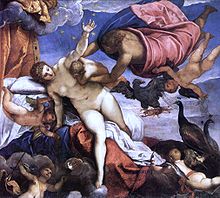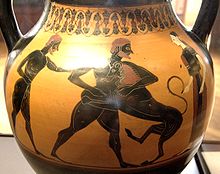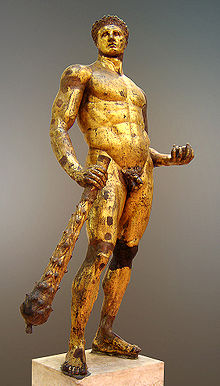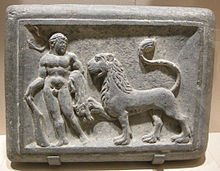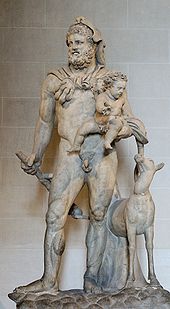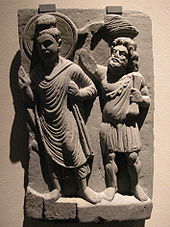- Heracles
-
This article is about the Greek mythic hero. For the Roman mythological analogue, see Hercules. For other uses, see Heracles (disambiguation).
Heracles 
One of the most famous depictions of him originally by Lysippos (Marble, Roman copy called Hercules Farnese, 216 CE)Gatekeeper of Olympus
God of heroes, sports, athletes, and divine protector of mankindAbode Mount Olympus Symbol Club, Nemean Lion, Bow and Arrows Consort Hebe Parents Zeus and Alcmene Children Alexiares and Anicetus, Telephus, Hyllus, Tlepolemus Roman equivalent Hercules Topics in Greek mythology - Gods
- Primordial gods and Titans
- Zeus and the Olympians
- Pan and the nymphs
- Apollo and Dionysus
- Sea-gods and Earth-gods
- Heroes
- Related
 Greek mythology portal
Greek mythology portalHeracles (
 /ˈhɛrəkliːz/ herr-ə-kleez; Ancient Greek: Ἡρακλῆς, Hēraklēs, from Hēra, "Hera", and kleos, "glory"[1]), born Alcaeus[2] (Ἀλκαῖος, Alkaios) or Alcides[3] (Ἀλκείδης, Alkeidēs), was a divine hero in Greek mythology, the son of Zeus (Ζεύς) and Alcmene, foster son of Amphitryon[4] and great-grandson (and half-brother) of Perseus (Περσεύς). He was the greatest of the Greek heroes, a paragon of masculinity, the ancestor of royal clans who claimed to be Heracleidae (Ἡρακλεῖδαι) and a champion of the Olympian order against chthonic monsters. In Rome and the modern West, he is known as Hercules, with whom the later Roman Emperors, in particular Commodus and Maximian, often identified themselves. The Romans adopted the Greek version of his life and works essentially unchanged, but added anecdotal detail of their own, some of it linking the hero with the geography of the Central Mediterranean. Details of his cult were adapted to Rome as well.
/ˈhɛrəkliːz/ herr-ə-kleez; Ancient Greek: Ἡρακλῆς, Hēraklēs, from Hēra, "Hera", and kleos, "glory"[1]), born Alcaeus[2] (Ἀλκαῖος, Alkaios) or Alcides[3] (Ἀλκείδης, Alkeidēs), was a divine hero in Greek mythology, the son of Zeus (Ζεύς) and Alcmene, foster son of Amphitryon[4] and great-grandson (and half-brother) of Perseus (Περσεύς). He was the greatest of the Greek heroes, a paragon of masculinity, the ancestor of royal clans who claimed to be Heracleidae (Ἡρακλεῖδαι) and a champion of the Olympian order against chthonic monsters. In Rome and the modern West, he is known as Hercules, with whom the later Roman Emperors, in particular Commodus and Maximian, often identified themselves. The Romans adopted the Greek version of his life and works essentially unchanged, but added anecdotal detail of their own, some of it linking the hero with the geography of the Central Mediterranean. Details of his cult were adapted to Rome as well.Extraordinary strength, courage, ingenuity, and sexual prowess with females were among his characteristic attributes. Although he was not as clever as the likes of Odysseus or Nestor, Heracles used his wits on several occasions when his strength did not suffice, such as when laboring for the king Augeas of Elis, wrestling the giant Antaeus, or tricking Atlas into taking the sky back onto his shoulders. Together with Hermes he was the patron and protector of gymnasia and palaestrae.[5] His iconographic attributes are the lion skin and the club. These qualities did not prevent him from being regarded as a playful figure who used games to relax from his labors and played a great deal with children.[6] By conquering dangerous archaic forces he is said to have "made the world safe for mankind" and to be its benefactor.[7] Heracles was an extremely passionate and emotional individual, capable of doing both great deeds for his friends (such as wrestling with Thanatos on behalf of Prince Admetus, who had regaled Heracles with his hospitality, or restoring his friend Tyndareus to the throne of Sparta after he was overthrown) and being a terrible enemy who would wreak horrible vengeance on those who crossed him, as Augeas, Neleus and Laomedon all found out to their cost.
Contents
Origin and character
Many popular stories were told of his life, the most famous being The Twelve Labours of Heracles; Alexandrian poets of the Hellenistic age drew his mythology into a high poetic and tragic atmosphere.[8] His figure, which initially drew on Near Eastern motifs such as the lion-fight, was known everywhere: his Etruscan equivalent was Hercle, a son of Tinia and Uni.
Heracles was the greatest of Hellenic chthonic heroes, but unlike other Greek heroes, no tomb was identified as his. Heracles was both hero and god, as Pindar says heroes theos; at the same festival sacrifice was made to him, first as a hero, with a chthonic libation, and then as a god, upon an altar: thus he embodies the closest Greek approach to a "demi-god".[8] The core of the story of Heracles has been identified by Walter Burkert as originating in Neolithic hunter culture and traditions of shamanistic crossings into the netherworld.[9]
Hero or god
Heracles' role as a culture hero, whose death could be a subject of mythic telling (see below), was accepted into the Olympian Pantheon during Classical times. This created an awkwardness in the encounter with Odysseus in the episode of Odyssey XI, called the Nekuia, where Odysseus encounters Heracles in Hades:
- And next I caught a glimpse of powerful Heracles—
- His ghost I mean: the man himself delights
- in the grand feasts of the deathless gods on high...
- Around him cries of the dead rang out like cries of birds
- scattering left and right in horror as on he came like night..."[10]
Ancient critics were aware of the problem of the aside that interrupts the vivid and complete description, in which Heracles recognizes Odysseus and hails him, and modern critics find very good reasons for denying that the verses beginning, in Fagles' translation His ghost I mean... were part of the original composition: "once people knew of Heracles' admission to Olympus, they would not tolerate his presence in the underworld", remarks Friedrich Solmsen,[11] noting that the interpolated verses represent a compromise between conflicting representations of Heracles.
It is also said that when Heracles died he shed his mortal skin, which went down to the underworld and he went up to join the gods for being the greatest hero ever known.
Christian dating
In Christian circles a Euhemerist reading of the widespread Heracles cult was attributed to a historical figure who had been offered cult status after his death. Thus Eusebius, Preparation of the Gospel (10.12), reported that Clement could offer historical dates for Hercules as a king in Argos: "from the reign of Hercules in Argos to the deification of Hercules himself and of Asclepius there are comprised thirty-eight years, according to Apollodorus the chronicler: and from that point to the deification of Castor and Pollux fifty-three years: and somewhere about this time was the capture of Troy."
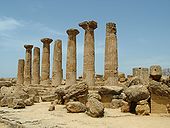 Temple to Heracles in Agrigento
Temple to Heracles in Agrigento
Readers with a literalist bent, following Clement's reasoning, have asserted from this remark that, since Heracles ruled over Tiryns in Argos at the same time that Eurystheus ruled over Mycenae, and since at about this time Linus was Heracles' teacher, one can conclude, based on Jerome's date—in his universal history, his Chronicon—given to Linus' notoriety in teaching Heracles in 1264 BC, that Heracles' death and deification occurred 38 years later, in approximately 1226 BC.
Cult
The ancient Greeks celebrated the festival of the Herakleia, which commemorated the death of Heracles, on the second day of the month of Metageitnion (which would fall in late July or early August). What is believed to be an Egyptian Temple of Heracles in the Bahariya Oasis dates to 21 BC.
Greek mythology
Birth and childhood
A major factor in the well-known tragedies surrounding Heracles is the hatred that the goddess Hera, wife of Zeus, had for him. A full account of Heracles must render it clear why Heracles was so tormented by Hera, when there were many illegitimate offspring sired by Zeus. Heracles was the son of the affair Zeus had with the mortal woman Alcmene. Zeus made love to her after disguising himself as her husband, Amphitryon, home early from war (Amphitryon did return later the same night, and Alcmene became pregnant with his son at the same time, a case of heteropaternal superfecundation, where a woman carries twins sired by different fathers).[12] Thus, Heracles' very existence proved at least one of Zeus' many illicit affairs, and Hera often conspired against Zeus' mortal offspring as revenge for her husband's infidelities. His twin mortal brother, son of Amphitryon, was Iphicles, father of Heracles' charioteer Iolaus.
On the night the twins Heracles and Iphicles were to be born, Hera, knowing of her husband Zeus' adultery, persuaded Zeus to swear an oath that the child born that night to a member of the House of Perseus would become High King. Hera did this knowing that while Heracles was to be born a descendant of Perseus, so too was Eurystheus. Once the oath was sworn, Hera hurried to Alcmene's dwelling and slowed the birth of the twins Heracles and Iphicles by forcing Ilithyia, goddess of childbirth, to sit crosslegged with her clothing tied in knots, thereby causing the twins to be trapped in the womb. Meanwhile, Hera caused Eurystheus to be born prematurely, making him High King in place of Heracles. She would have permanently delayed Heracles' birth had she not been fooled by Galanthis, Alcmene's servant, who lied to Ilithyia, saying that Alcmene had already delivered the baby. Upon hearing this, she jumped in surprise, loosing the knots and inadvertently allowing Alcmene to give birth to Heracles and Iphicles.
Fear of Hera's revenge led Alcmene to expose the infant Heracles, but he was taken up and brought to Hera by his half-sister Athena, who played an important role as protectress of heroes. Hera did not recognize Heracles and nursed him out of pity. Heracles suckled so strongly that he caused Hera pain, and she pushed him away. Her milk sprayed across the heavens and there formed the Milky Way. But with divine milk, Heracles had acquired supernatural powers. Athena brought the infant back to his mother, and he was subsequently raised by his parents.
The child was originally given the name Alcides by his parents; it was only later that he became known as Heracles.[4] He was renamed Heracles in an unsuccessful attempt to mollify Hera. He and his twin were just eight months old when Hera sent two giant snakes into the children's chamber. Iphicles cried from fear, but his brother grabbed a snake in each hand and strangled them. He was found by his nurse playing with them on his cot as if they were toys. Astonished, Amphitryon sent for the seer Tiresias, who prophesied an unusual future for the boy, saying he would vanquish numerous monsters.
Youth
After killing his music tutor Linus with a lyre, he was sent to tend cattle on a mountain by his foster father Amphitryon. Here, according to an allegorical parable, "The Choice of Heracles", invented by the sophist Prodicus (c. 400 BC) and reported in Xenophon's Memorabilia 2.1.21-34, he was visited by two nymphs—Pleasure and Virtue—who offered him a choice between a pleasant and easy life or a severe but glorious life: he chose the latter. This was part of a pattern of "ethicizing" Heracles over the fifth century BC.[13]
Later in Thebes, Heracles married King Creon's daughter, Megara. In a fit of madness, induced by Hera, Heracles killed his children by Megara. After his madness had been cured with hellebore by Antikyreus, the founder of Antikyra,[14] he realized what he had done and fled to the Oracle of Delphi. Unbeknownst to him, the Oracle was guided by Hera. He was directed to serve King Eurystheus for ten years and perform any task Eurystheus required of him. Eurystheus decided to give Heracles ten labours, but after completing them, Heracles was cheated by Eurystheus when he added two more, resulting in the Twelve Labors of Heracles.
Labours of Heracles
Main article: Labours of HerculesDriven mad by Hera, Heracles slew his own children. To expiate the crime, Heracles was required to carry out ten labors set by his archenemy, Eurystheus, who had become king in Heracles' place. If he succeeded, he would be purified of his sin and, as myth says, he would be granted immortality. Heracles accomplished these tasks, but Eurystheus did not accept the cleansing of the Augean stables because Heracles was going to accept pay for the labor. Neither did he accept the killing of the Lernaean Hydra as Heracles' cousin, Ioloas, had helped him burn the stumps of the heads. Eurysteus set two more tasks (fetching the Golden Apples of Hesperides and capturing Cerberus), which Heracles performed successfully, bringing the total number of tasks up to twelve.
Not all writers gave the labors in the same order. Apollodorus (2.5.1-2.5.12) gives the following order:
- To kill the Nemean lion.
- To destroy the Lernaean Hydra.
- To capture the Ceryneian Hind.
- To capture the Erymanthian Boar.
- To clean the Augean Stables.
- To kill the Stymphalian Birds.
- To capture the Cretan Bull.
- To round up the Mares of Diomedes.
- To steal the Girdle of Hippolyte.
- To herd the Cattle of Geryon.
- To fetch the Apples of Hesperides.
- To capture Cerberus.
Further adventures
After completing these tasks, Heracles joined the Argonauts in a search for the Golden Fleece. They rescued heroines, conquered Troy, and helped the gods fight against the Gigantes. He also fell in love with Princess Iole of Oechalia. King Eurytus of Oechalia promised his daughter, Iole, to whoever could beat his sons in an archery contest. Heracles won but Eurytus abandoned his promise. Heracles' advances were spurned by the king and his sons, except for one: Iole's brother Iphitus. Heracles killed the king and his sons–excluding Iphitus–and abducted Iole. Iphitus became Heracles' best friend. However, once again, Hera drove Heracles mad and he threw Iphitus over the city wall to his death. Once again, Heracles purified himself through three years of servitude — this time to Queen Omphale of Lydia.
Omphale
Main article: OmphaleOmphale was a queen or princess of Lydia. As penalty for a murder, imposed by Xenoclea, the Delphic Oracle, Heracles was to serve as her slave for a year. He was forced to do women's work and to wear women's clothes, while she wore the skin of the Nemean Lion and carried his olive-wood club. After some time, Omphale freed Heracles and married him. Some sources mention a son born to them who is variously named. It was at that time that the cercopes, mischievous wood spirits, stole Heracles' weapons. He punished them by tying them to a stick with their faces pointing downward.
Hylas
While walking through the wilderness, Heracles was set upon by the Dryopes. In Apollonius of Rhodes' Argonautica it is recalled that Heracles had mercilessly slain their king, Theiodamas, over one of the latter's bulls, and made war upon the Dryopes "because they gave no heed to justice in their lives".[15] After the death of their king, the Dryopes gave in and offered him Prince Hylas. He took the youth on as his weapons bearer and beloved. Years later, Heracles and Hylas joined the crew of the Argo. As Argonauts, they only participated in part of the journey. In Mysia, Hylas was kidnapped by the nymphs of a local spring. Heracles, heartbroken, searched for a long time but Hylas had fallen in love with the nymphs and never showed up again. In other versions, he simply drowned. Either way, the Argo set sail without them.
Rescue of Prometheus
Hesiod's Theogony and Aeschylus' Prometheus Unbound both tell that Heracles shot and killed the eagle that tortured Prometheus (which was his punishment by Zeus for stealing fire from the gods and giving it to mortals). Heracles freed the Titan from his chains and his torments. Prometheus then made predictions regarding further deeds of Heracles.
Heracles' Constellation
On his way back to Mycenae from Iberia, having obtained the Cattle of Geryon as his tenth labour, Heracles came to Liguria in North-Western Italy where he engaged into battle with two giants, Albion and Bergion or Dercynus, sons of Poseidon. The opponents were strong; Hercules was in a difficult position so he prayed to his father Zeus for help. Under the aegis of Zeus, Heracles won the battle. It was this kneeling position of Heracles when prayed to his father Zeus that gave the name Engonasin ("Εγγόνασιν", derived from "εν γόνασιν"), meaning "on his knees" or "the Kneeler" one constellation known as Heracles' constellation. The story, among others, is described by Dionysius of Halicarnassus.[16]
Laomedon of Troy
Before the Trojan War, Poseidon sent a sea monster to attack Troy. The story is related in several digressions in the Iliad (7.451-453, 20.145-148, 21.442-457) and is found in Apollodorus' Bibliotheke (2.5.9). Laomedon planned on sacrificing his daughter Hesione to Poseidon in the hope of appeasing him. Heracles happened to arrive (along with Telamon and Oicles) and agreed to kill the monster if Laomedon would give him the horses received from Zeus as compensation for Zeus' kidnapping Ganymede. Laomedon agreed. Heracles killed the monster, but Laomedon went back on his word. Accordingly, in a later expedition, Heracles and his followers attacked Troy and sacked it. Then they slew all Laomedon's sons present there save Podarces, who was renamed Priam, who saved his own life by giving Heracles a golden veil Hesione had made. Telamon took Hesione as a war prize; they were married and had a son, Teucer.
Other adventures
Heracles defeated the Bebryces (ruled by King Mygdon) and gave their land to Prince Lycus of Mysia, son of Dascylus.
- He killed the robber Termerus.
- Heracles visited Evander with Antor, who then stayed in Italy.
- Heracles killed King Amyntor of the Dolopes for not allowing him into his kingdom. He also killed King Emathion of Arabia.
- Heracles killed Lityerses after beating him in a contest of harvesting.
- Heracles killed Periclymenus at Pylos.
- Heracles founded the city Tarentum (modern Taranto in Italy).
- Heracles learned music from Linus (and Eumolpus), but killed him after Linus corrected his mistakes. He learned how to wrestle from Autolycus. He killed the famous boxer Eryx of Sicily in a match.
- Heracles was an Argonaut. He killed Alastor and his brothers.
- When Hippocoon overthrew his brother, Tyndareus, as King of Sparta, Heracles reinstated the rightful ruler and killed Hippocoon and his sons.
- Heracles slew the giants Cycnus, Porphyrion and Mimas. The expedition against Cycnus, in which Iolaus accompanied Heracles, is the ostensible theme of a short epic attributed to Hesiod, The Shield of Heracles.
- Heracles killed Antaeus the giant who was immortal while touching the earth, by picking him up and holding him in the air while strangling him.
- Heracles went to war with Augeias after he denied him a promised reward for clearing his stables. Augeias remained undefeated due to the skill of his two generals, the Molionides, and after Heracles fell ill, his army was badly beaten. Later, however, he was able to ambush and kill the Molionides, and thus march into Elis, sack it, and kill Augeias and his sons.
- Heracles visited the house of Admetus on the day Admetus' wife, Alcestis, had agreed to die in his place. By hiding beside the grave of Alcestis, Heracles was able to surprise Death when he came to collect her, and by squeezing him tight until he relented, was able to persuade Death to return Alcestis to her husband.
- Heracles challenged wine god Dionysus to a drinking contest and lost, resulting in his joining the Thiasus for a period.
- Heracles also appears in Aristophanes' The Frogs, in which Dionysus seeks out the hero to find a way to the underworld. Heracles is greatly amused by Dionysus' appearance and jokingly offers several ways to commit suicide before finally offering his knowledge of how to get to there.
- Heracles appears as the founder of Scythia in Herodotus' text. While Heracles is sleeping out in the wilderness, a half-woman, half-snake creature steals his horses. Heracles eventually finds the creature, but she refuses to return the horses until he has sex with her. After doing so, he takes back his horses, but before leaving, he hands over his belt and bow, and gives instructions as to which of their children should found a new nation in Scythia.
Lovers
Women
During the course of his life, Heracles married four times. His first marriage was to Megara, whose children he murdered in a fit of madness. Apollodoros (Bibliotheke) recounts that Megara was unharmed and given in marriage to Iolaus, while in Euripides' version Heracles killed Megara, too.
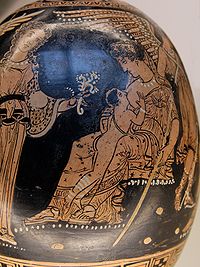 The topos of Heracles suckling at Hera's breast was especially popular in Magna Graecia, here on a mid-4th century Apulian painted vase; Etruscan mythology adopted this iconic image
The topos of Heracles suckling at Hera's breast was especially popular in Magna Graecia, here on a mid-4th century Apulian painted vase; Etruscan mythology adopted this iconic image
His second wife was Omphale, the Lydian queen or princess to whom he was delivered as a slave.
His third marriage was to Deianira, for whom he had to fight the river god Achelous (upon Achelous' death, Heracles removed one of his horns and gave it to some nymphs who turned it into the cornucopia.) Soon after they wed, Heracles and Deianira had to cross a river, and a centaur named Nessus offered to help Deianira across but then attempted to rape her. Enraged, Heracles shot the centaur from the opposite shore with a poisoned arrow (tipped with the Lernaean Hydra's blood) and killed him. As he lay dying, Nessus plotted revenge, told Deianira to gather up his blood and spilled semen and, if she ever wanted to prevent Heracles from having affairs with other women, she should apply them to his vestments. Nessus knew that his blood had become tainted by the poisonous blood of the Hydra, and would burn through the skin of anyone it touched.
Later, when Deianira suspected that Heracles was fond of Iole, she soaked a shirt of his in the mixture, creating the poisoned shirt of Nessus. Heracles' servant, Lichas, brought him the shirt and he put it on. Instantly he was in agony, the cloth burning into him. As he tried to remove it, the flesh ripped from his bones. Heracles chose a voluntary death, asking that a pyre be built for him to end his suffering. After death, the gods transformed him into an immortal, or alternatively, the fire burned away the mortal part of the demigod, so that only the god remained. After his mortal parts had been incinerated, he could become a full god and join his father and the other Olympians on Mount Olympus. He then married Hebe, his fourth and last wife.
Affairs
Another episode of his female affairs that stands out was his stay at the palace of Thespius king of Thespiae, who wished him to kill the Lion of Cithaeron. As a reward, the king offered him the chance to make love to his daughters, all fifty of them, in one night. Heracles complied and they all became pregnant and all bore sons. This is sometimes referred to as his Thirteenth Labour. Many of the kings of ancient Greece traced their lines to one or another of these, notably the kings of Sparta and Macedon.
Yet another episode of his female affairs that stands out was when he carried away the oxen of Geryones, he also visited the country of the Scythians. Once while he was asleep there, his horses suddenly disappeared, and when he woke and wandered about in search of them, he came into the country of Hylaea. He there found the monster Echidna in a cave. When he asked whether she knew anything about his horses, she answered, that they were in her own possession, but that she would not give them up, unless he would consent to stay with her for a time. Heracles accepted the request, and became by her the father of Agathyrsus, Gelonus, and Scythes. The last of them became king of the Scythians, according to his father's arrangement, because he was the only one among the three brothers that was able to manage the bow which Heracles had left behind, and to use his father's girdle.[17]
Children
Main article: HeracleidaeTelephus is the son of Heracles and Auge. Hyllus is the son of Heracles and Deianeira or Melite. The sons of Heracles and Hebe are Alexiares and Anicetus.
There is also, in some versions, reference to an episode where Heracles met and impregnated a half-serpentine woman, known as Echidna; her children, known as the Dracontidae, were the ancestors of the House of Cadmus.
According to Herodotus, a line of 22 Kings of Lydia descended from Hercules and Omphale. The line was called Tylonids after his Lydian name.
Children and consorts
- Megara
- Therimachus
- Creontiades
- Ophitus
- Deicoon
- Omphale
- Agelaus
- Tyrsenus
- Deianira
- Hebe
- Alexiares
- Anicetus
- Astydameia, daughter of Ormenius
- Ctesippus
- Astyoche, daughter of Phylas
- Tlepolemus
- Auge
- Telephus
- Autonoe, daughter of Pireus / Iphinoe, daughter of Antaeus
- Palaemon
- Barge
- Bargasus[18]
- Bolbe
- Celtine
- Celtus
- Chalciope
- Echidna
- Agathyrsus
- Gelonus
- Skythes
- Epicaste
- Thestalus
- Meda
- Antiochus
- Myrto
- Parthenope, daughter of Stymphalus
- Everes
- Phialo
- Aechmagoras
- Psophis
- Pyrene
- none known
- Rhea, Italian priestess
- 50 daughters of Thespius
- 50 sons, see Thespius#Daughters and grandchildren
- Unnamed Celtic woman
- Galates[20]
- Unnamed slave of Omphale
- Alcaeus / Cleodaeus
- Unknown consorts
Death
 Hercules killing Centaur Nessus (marble by Giambologna, Florence)
Hercules killing Centaur Nessus (marble by Giambologna, Florence)
This is described in Ovid's Metamorphoses Book IX. Having wrestled and defeated Achelous, god of the Acheloos river, Heracles takes Deianira as his wife. Travelling to Tiryns, a centaur, Nessus, offers to help Deianira across a fast flowing river while Heracles swims it. However, Nessus is true to the archetype of the mischievous centaur and tries to steal Deianira away while Heracles is still in the water. Angry, Heracles shoots him with his arrows dipped in the poisonous blood of the Lernaean Hydra. Thinking of revenge, Nessus gives Deianira his blood-soaked tunic before he dies, telling her it will "excite the love of her husband".[26]
Several years later, rumor tells Deianira that she has a rival for the love of Heracles. Deianira, remembering Nessus' words, gives Heracles the bloodstained shirt. Lichas, the herald, delivers the shirt to Heracles. However, it is still covered in the Hydra's blood from Heracles' arrows, and this poisons him, tearing his skin and exposing his bones. Before he dies, Heracles throws Lichas into the sea, thinking he was the one who poisoned him (according to several versions, Lichas turns to stone, becoming a rock standing in the sea, named for him). Heracles then uproots several trees and builds a funeral pyre, which Poeas, father of Philoctetes, lights. As his body burns, only his immortal side is left. Through Zeus' apotheosis, Heracles rises to Olympus as he dies.
No one but Heracles' friend Philoctetes (Poeas in some versions) would light his funeral pyre (in an alternate version, it is Iolaus who lights the pyre). For this action, Philoctetes or Poeas received Heracles' bow and arrows, which were later needed by the Greeks to defeat Troy in the Trojan War. Philoctetes confronted Paris and shot a poisoned arrow at him. The Hydra poison would subsequently lead to the death of Paris. The Trojan War, however, would continue until the Trojan Horse was used to defeat Troy.
Hercules in Rome
Main article: HerculesIn Rome, Heracles was honored as Hercules, and had a number of distinctively Roman myths and practices associated with him under that name.
Heracles in other cultures
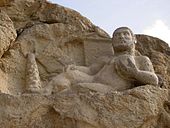 Hellenistic-era depiction of the Zoroastrian divinity Bahram as Hercules carved in 153 B.C. at Kermanshah, Iran.
Hellenistic-era depiction of the Zoroastrian divinity Bahram as Hercules carved in 153 B.C. at Kermanshah, Iran. See also: Hercules in popular culture
See also: Hercules in popular cultureVia the Greco-Buddhist culture, Heraclean symbolism was transmitted to the far east. An example remains to this day in the Nio guardian deities in front of Japanese Buddhist temples. Herodotus connected Heracles both to Phoenician god Melqart and to the Egyptian god Shu. Temples dedicated to Heracles abounded all along the Mediterranean coastal countries. For example the temple of Heracles Monoikos (i.e. the lone dweller), built far from any nearby town upon a promontory in what is now the Côte d'Azur, gave its name to the area's more recent name, Monaco.
The gateway to the Mediterranean Sea from the Atlantic Ocean, where the southernmost tip of Spain and the northernmost of Morocco face each other, is, classically speaking, referred to as the Pillars of Hercules/Heracles, owing to the story that he set up two massive spires of stone to stabilise the area and ensure the safety of ships sailing between the two landmasses.
Spoken word myths
Bibliography of reconstruction: Homer, Odyssey, 12.072 (7th c. BC); Theocritus, Idylls, 13 (350–310 BC); Callimachus, Aetia (Causes), 24. Thiodamas the Dryopian, Fragments, 160. Hymn to Artemis (310–250? BC); Apollonios Rhodios, Argonautika, I. 1175 - 1280 (c. 250 BC); Apollodorus, Library and Epitome 1.9.19, 2.7.7 (140 BC); Sextus Propertius, Elegies, i.20.17ff (50–15 BC); Ovid, Ibis, 488 (AD 8–18); Gaius Valerius Flaccus, Argonautica, I.110, III.535, 560, IV.1-57 (1st century); Hyginus, Fables, 14. Argonauts Assembled (1st century); Philostratus the Elder, Images, ii.24 Thiodamas (170–245); First Vatican Mythographer, 49. Hercules et Hylas
Ancestry[27]
Zeus Danaë Perseus Andromeda Perses Alcaeus Hipponome Electryon Anaxo Sthenelus Menippe Mestor Anaxo Amphitryon Alcmene Zeus Licymnius Eurystheus Iphicles Megara Heracles Deianira Hebe Iolaus Three Children Hyllus Macaria Others See also
Other figures in Greek mythology punished by the gods include:
Notes
- ^ Becking, Bob, et al.. Dictionary of deities and demons. ed. Toorn,Karel van der. Wm. B. Eerdmans Publishing. 1999
- ^ Schmitz, Leonhard (1867). "Alceides". In William Smith. Dictionary of Greek and Roman Biography and Mythology. 1. Boston: Little, Brown and Company. pp. 98. http://www.ancientlibrary.com/smith-bio/0107.html.
- ^ Apollodorus, ii. 4. § 12
- ^ a b (Ἀμφιτρύων). By his adoptive descent through Ampitryon, Heracles receives the epithet Alcides, as "of the line of Alcaeus", father of Amphitryon. Amphitryon's own, mortal son was Iphicles.
- ^ Pausanias, Guide to Greece, 4.32.1
- ^ Aelian, Varia Historia, 12.15
- ^ Aelian, Varia Historia, 5.3
- ^ a b Burkert 1985, pp. 208-9
- ^ Burkert 1985, pp. 208-212.
- ^ Robert Fagles' translation, 1996:269.
- ^ Friedrich Solmsen, "The Sacrifice of Agamemnon's Daughter in Hesiod's' Ehoeae" The American Journal of Philology 102.4 (Winter 1981, pp. 353–358), p. 355.
- ^ Compare the two pairs of twins born to Leda and the "double" parentage of Theseus.
- ^ Andrew Ford, Aristotle as Poet, Oxford, 2011, p. 208 n. 5, citing, in addition to Prodicus/Xenophon, Antisthenes, Herodorus (esp. FGrHist 31 F 14), and (in the fourth century) Plato's use of "Heracles as a figure for Socrates' life (and death?): Apology 22a, cf. Theaetetus 175a, Lysis 205c."
- ^ Pausanias Χ 3.1, 36.5. Ptolemaeus, Geogr. Hyph. ΙΙ 184. 12. Stephanus of Byzantium, s.v. «Aντίκυρα»
- ^ Richard Hunter, translator, Jason and the Golden Fleece (Oxford:Clarendon Press), 1993, p 31f.
- ^ Dionysius of Halicarnassus, i. 41
- ^ Herodotus, Histories IV. 8-10.
- ^ Stephanus of Byzantium s. v. Bargasa
- ^ Virgil, Aeneid, 7. 655 ff
- ^ Diodorus Siculus, Library of History, 5. 24. 2
- ^ Statius, Thebaid, 6. 837, 10. 249
- ^ Stephanus of Byzantium s. v. Amathous
- ^ Statius, Thebaid, 6. 346
- ^ Dionysius of Halicarnassus, Roman Antiquities, 1. 50. 4
- ^ Hyginus, Fabulae, 162
- ^ Ovid, Metamorphoses, IX l.132-3
- ^ Morford, M.P.O, Lenardon R.J.(2007)Classical Mythology. pp. 865 Oxford: Oxford University Press.
Modern sources
- Kerenyi, Karl (1959). The Heroes of the Greeks. New York/London: Thames and Hudson.
References
- Heracles at Theoi.com Classical literature and art
- Timeless Myths – Heracles The life and adventure of Heracles, including his twelve labours.
- Heracles, Greek Mythology Link
- Heracles (in French)
- Vollmer: Herkules (1836, in German)
- Burkert, Walter, (1977) 1985. Greek Religion (Harvard University Press).
Further reading
- Padilla, Mark W. (1998). "Herakles and Animals in the Origins of Comedy and Satyr Drama". In Le Bestiaire d'Héraclès: IIIe Rencontre héracléenne, edited by Corinne Bonnet, Colette Jourdain-Annequin, and Vinciane Pirenne-Delforge, 217-30. Kernos Suppl. 7. Liège: Centre International d'Etude de la Religion Grecque Antique.
- Padilla, Mark W. (1998). "The Myths of Herakles in Ancient Greece: Survey and Profile". Lanham, Maryland: University Press of America.
External links
 Media related to Heracles at Wikimedia CommonsCategories:
Media related to Heracles at Wikimedia CommonsCategories:- Heracles
- Argonauts
- Demigods of Classical mythology
- Greek gods
- Greek mythology
- Greek mythological hero cult
- Monomyths
- Labours of Hercules
- Offspring of Zeus
- Oracular gods
- Savior gods
- Greek culture heroes
- Heroes who ventured to Hades
Wikimedia Foundation. 2010.

